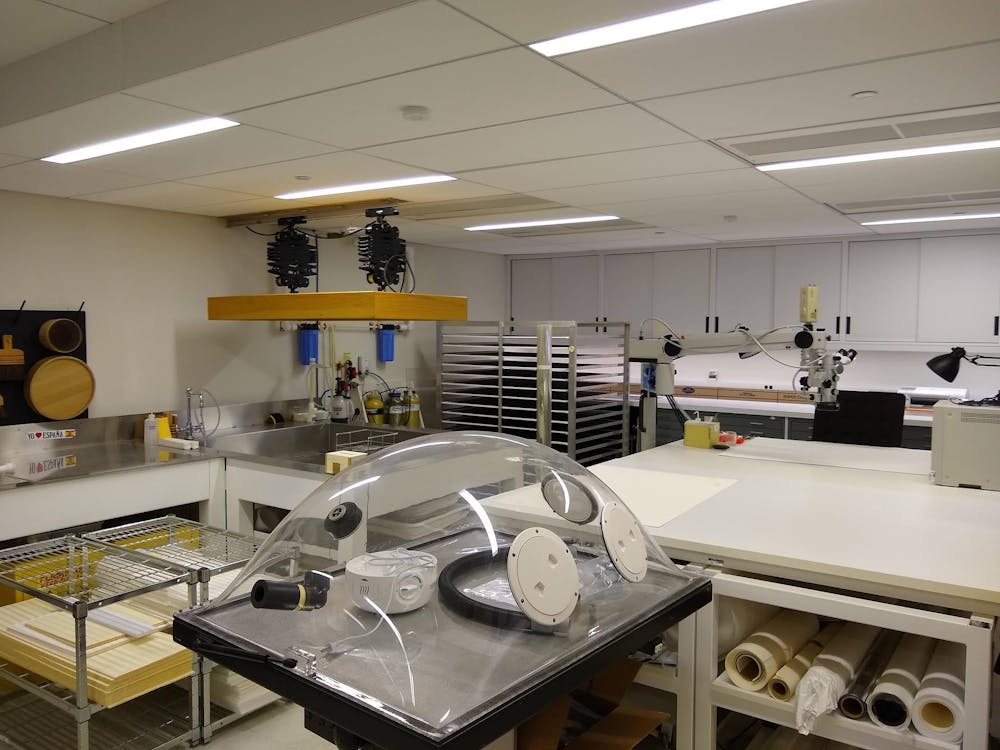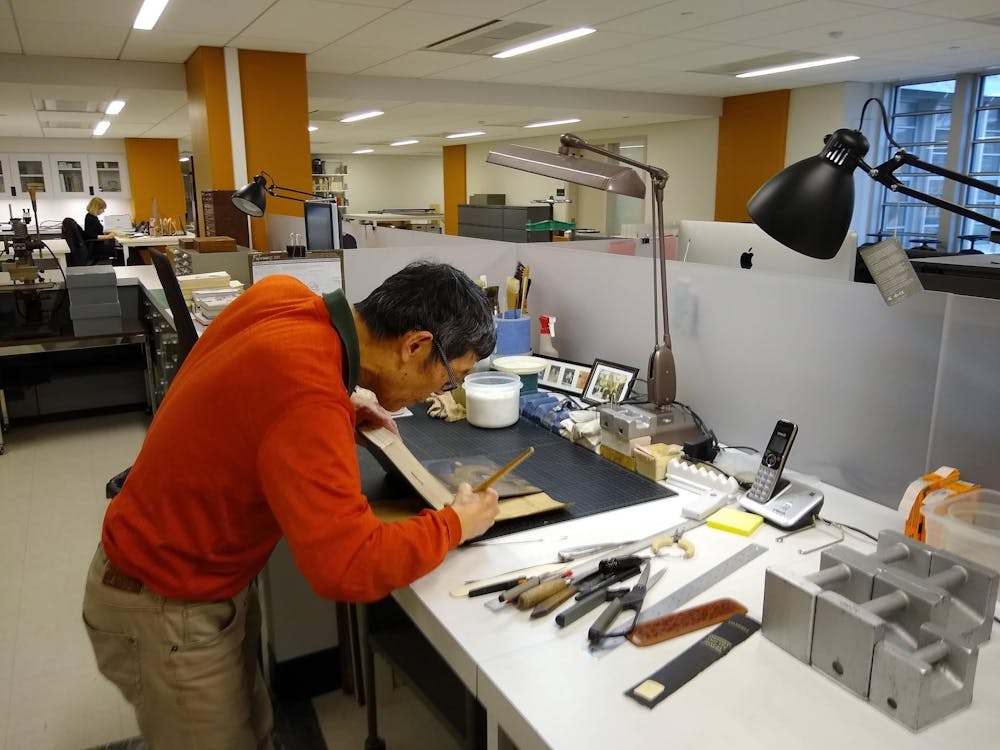The University is always changing.
Forbes is incorporating Pink House to create a four-year residential college. The Block 95 meal plan will soon be a thing of the past. Scudder Plaza boasts a new — and controversial — colossus of a sculpture. Electric scooters are no longer allowed inside buildings. Every one of the University’s changes aims — well, plainly — to change things. But there’s one exception to that rule.
Here are some items to which the University library system plays host: 11 million total holdings. 100,000 rare coins. Ancient tablets. Papyri. The box in which the 1765 Stamp Act traveled from King George’s court to the colonies. The first six printed editions of the Bible. Shakespeare’s first four folios.
Here are some issues with which Firestone Library must contend: Dust. Mold. Humidity. Acidity. Graceless students. The destruction wrought by mice. Time.
So, this, lurking a stairwell and a world below the Library’s airy lobby, is Firestone’s solution to that slew of threats: the Conservation Lab, where things change to stay the same.
The Conservation Lab has two divisions: General Collections Conservation and Special Collections Conservation. While General Collections Conservation handles the vast majority of the University’s holdings, Special Collections is responsible for the Library’s treasures.
Access to the C Floor’s Special Collections unit is already tightly controlled. Visitors must stow all possessions in designated lockers before entering. A security guard directs them to wash their hands before buzzing into the Reading Room. The room itself is lined with no fewer than 20 bullet cameras.
Director of Library Communications Barbara Valenza was noticeably tightlipped when it came to Special Collections’ additional security measures.

“Only the people who need to know, know,” she said.
Special Collections’ protections may seem excessive, but research libraries have found themselves the frequent targets of burglary attempts. Rare maps dealer and serial thief Edward Forbes Smiley III was discovered in 2005 in Yale University’s Beinecke Rare Book and Manuscript Library cutting out maps with an X-Acto knife; in 1969, a robber almost stole Harvard University’s 1455 Gutenberg Bible but fell from a rope and injured himself.
The video cameras, handwashing, and prohibition on pens can protect Special Collections’ holdings from disaster, but not everyday decline. This much is inevitable: everything ages.
So when circulation desk staff or Special Collections archivists find a holding damaged — binding broken, page torn, illustration faded — they send it below ground, to the Conservation Lab. If it is particularly old or valuable, technicians treat the piece in-house. If the damage is minor and the holding comparatively unimportant, conservators ship it off to a commercial bindery.

Before treatment begins, conservators file a condition report, and the curator responsible for the holding signs a treatment proposal. Curators and conservators work in tandem; the former might be aware of a fault of historical significance — like the Liberty Bell’s famous crack — that a conservator might be tempted to repair.
And then they get to work.

In the foreground, a suction table and humidity board, used primarily to clean artwork with water without allowing the color to bleed. Behind it, a vat where materials are sometimes submerged for cleaning.
Photo Credit: James Anderson / The Daily Princetonian
Strewn around the bright and busy Conservation Lab are the tools on which conservators have relied for centuries: pastes and glues, fibrous sheets of Japanese paper called kozo, bone folders, needles for resewing bindings. In one corner sits a machine for extracting moisture from works, near a vat where paper — only the sturdiest kind — is washed. Arranged around the room are boxes and sheaths and racks for unbound pages.
During this reporter’s visit to the lab, Project Conservator Victoria Wong was bent over her desk. On it sat a Cyrillic language book with a small gouge through its pages. Slowly, meticulously, Wong prepared variously-colored sheets of kozo paper to cover the hole.
“Because the gouge goes through the whole book,” she said, “I basically had to tone papers to match all the inks that it goes through.”
Near her, Rare Books Conservator Mick LeTourneaux was repairing a book dating from Rome, 1576. The tome’s raised-band binding had broken; only strips of vellum — animal skin or membrane strips — held the covers together.
LeTourneaux said he would use a humidification process to flatten some of the pages, then strip the joints and reinforce them with wheat paste.
Most of the Firestone conservators’ work comprises minor, routine repairs. Sometimes, though, despite best efforts — most of Special Collections’ holdings live in a vault that self-fills with oxygen-repelling gas in the event of fire — calamity strikes. The last one was in December 2018; as the library was renovated, a worker accidentally set off a first floor sprinkler. Water seeped down to the A Level stacks, endangering over 20,000 books.
Even in the face of those large-scale emergencies, the Conservation Lab doesn’t panic.
“It was amazing,” said preservation librarian Brenna Campbell. “We had staff helping, we had students helping, and we had teams of people sorting wet books from dry books.”
Several hundred books were carted down to the Lab. In the end, only about 20 had to be replaced. Disaster was averted, but Campbell noted that those “collections emergencies” may soon become the new normal. Climate change, she says, threatens to make conservators’ work increasingly difficult, as storms become increasingly severe.
No matter the cause of the damage — storm, flood, or careless reader — Firestone’s ethics of book preservation remain the same. Above all, the conservators seek to preserve history.
“It might be better to preserve the historic sewing structure even if it’s kind of weak than to resew it and lose that piece of material history,” Campbell said.
As a general rule, the Lab uses a light touch and, when possible, makes changes that can later be reversed.
“It’s not about making something new or restoring it in that sense,” Campbell said. “It’s more about what needs to happen to make that book or that document stable enough to be used by scholars.”
Once it has been restored, back above-ground — without fanfare or fuss — travels the book, manuscript, or print, to its shelf or vault, for a new cycle of readers and repairs.








